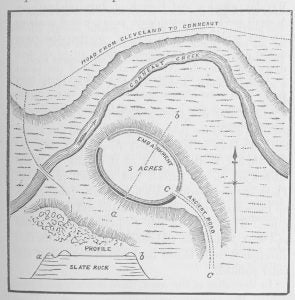Main Body
FORTIFIED HILL NEAR CONNEAUT
On the south side of the creek above the village of Conneaut, in Ashtabula county, is a detached mound of shale, about seventy feet high, which is crowned with an ancient fortress, or strong-hold, represented in the plan here inserted.

On the north side there is a low bank of earth following the crest of the hill. There is here no berme, or level space, outside of the embankment.
On the south side, where the bluff is not as steep and difficult of ascent as on the north, there is a ditch between the parapet and the crest, as represented in the profile, a, b. Outside of the ditch is a low bank on the edge of the natural slope. Thus the side having the least natural strength, was made stronger by art. It would be almost impossible, for men to ascend the steep escarpment of soap stone on the north. A narrow ridge of gentle ascent, allows of an easy grade on the south-eastern side, where there was in 1840, the remains of an ancient road.
This leads to the gateway at c, where there must have been some obstructions of wood like a “porte cullois,” which inmates could open and close at their pleasure. Why there should have been an opening in the enclosing wall, at the end next the river is not apparent. Within the enclosure, embracing about five acres, the soil is black and rich, while it is clayey and lean without. This is a common feature of the old earth-works on Lake Erie. It indicates a lengthy occupation of the place, by human beings. The ground occupied by Indian villages in the north, is always more fertile than the same soil outside of their towns.
In the valley of the creek, there is much good land which the ancients no doubt cultivated. These strong natural positions, resemble the fortified villages of the Moques, on the waters of the Colorado; which were visited and described by Prof. J. S. Newberry in 1854.
If the North American Indians, had been found intrenched in earth-works, when the whites first knew them; or possessed traditions concerning them, we should attribute the small forts which are upon the waters of Lake Erie, to them. But I have not seen among descriptions of the early French writers, any thing of the kind more permanent than pickets an stockades.

